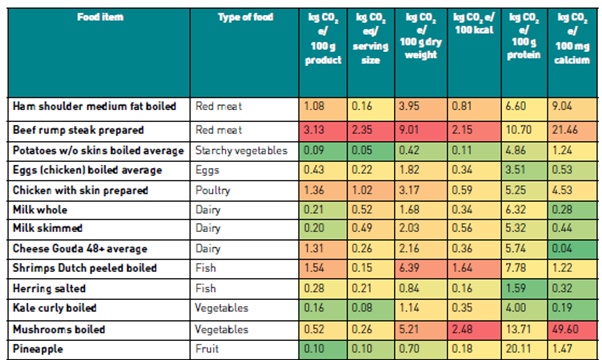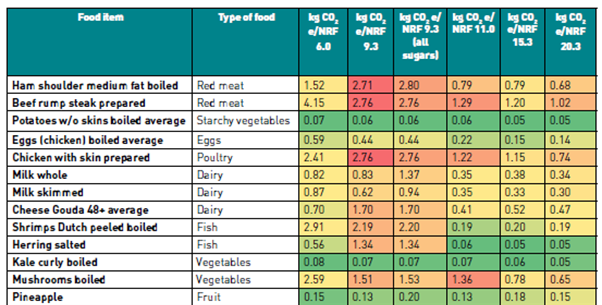04 May Nutrition metrics: the challenge of simplifying complexity
In a previous Thought for Food article, we explored nLCA (nutritional life cycle assessments). nLCA couple nutrition with environmental impact data to provide a single number output for a food, representative of its value and impact for both aspects. Here, we will look in more detail at the various nutrition metrics that form the nutrition half of an nLCA, discuss their respective values and limitations, and give some examples of their use.
What are nutrition metrics?
We know that food is a big driver of impacts on human health and on the environment, ranging from positive, to neutral, to negative. We also know that food is a huge economic sector that is under justified pressure to quantify and mitigate all harms caused.
Thus, there is a movement towards using metrics for foods that capture the diverse aspects of sustainability, making the complexity of these topics easier to understand. These metrics can then assist in decision making, from consumer purchasing to government policy. An example incorporating environmental sustainability is the Enviroscore: a metric combining 13 environmental impact categories for a food product into a single rating, aimed at consumer labelling.
While environmental impact is often the first thing that comes to mind when discussing food sustainability, the nutritional aspects of food are also being converted into metrics. The goal of these metrics is to appropriately capture the nutritional value of foods so that they can be compared.
So how should we compare the value of food?
Often, one of the main drivers of nutrition metric development is their ability to be combined with environmental data. Many have called for metrics that quantify a food’s “environmental impact per nutritional value”. An example is greenhouse gas emissions per gram protein. In this context, the nutrition metric is the functional unit. The challenge is how to define a nutrition metric that appropriately captures the nutritional value of food. The above example simply compares only one aspect of environmental impact (emissions) with one aspect of nutrition (protein), and therefore omits a large amount of other data and considerations.
The simplest approaches are to use a single value, for example: weight, servings, kcal, grams of protein, or grams of some other nutrient. While these are all appealingly simple, and widely used in scientific literature, they give us only a very narrow view of a food’s value that, at most, covers nutrient content, not nutritional value. When using these metrics, the relative performance of foods can vary widely depending on which nutrient is chosen.

These simple metrics are useful in a very small set of cases. For example, if comparing different brands of pea protein concentrate, grams of protein might be an appropriate unit, since no other nutritional component exists, and the protein composition should be consistent.
But we wouldn’t choose kcal as a nutritional unit for comparing sugar with vegetables. The high caloric content of sugar would earn it a better score, despite its poorer nutritional value.
A more sophisticated approach is to use nutrition metrics that consider multiple nutrients. Some examples include the Nutrient Rich Food (NRF) metrics, the UKNIprot metrics, the Weighted Nutrient Density Score (WNDS), and many more. These metrics pull together content of multiple nutrients, sometimes in combination with other data about the food, to produce an aggregate score.
While this is an improved approach, many questions must be addressed when building these metrics. Which nutrients should be included? Which are beneficial versus harmful? Are some nutrients more important than others, and if so, should they be weighted in the calculation? Is there a limit to how high a score can be attained? Is there a reliable source for the necessary data for all food items?
Finally, given the number of these metrics and how each has approached these questions in slightly different ways, which is best? Currently, there is no one best score that has been widely agreed upon, and more appear each year. Just as with single nutrient values, comparisons between food items lead to different conclusions depending on the metric chosen.

Recent novel approaches
To get closer to nutrition and human requirements, approaches with higher data requirements have emerged.
One approach is to think about bioavailable nutrient content, rather than just total content. Given the good data available for protein and amino acid composition and digestibility, it’s now possible to compare foods on their content of bioavailable essential amino acids, rather than simply grams of protein. However, bioavailability data for other nutrients is lacking, preventing a universal approach, but this should not stop the inclusion of bioavailability into existing metrics that include protein.
A second novel approach is to see how a food matches up to the nutritional needs of a specific population, demographic, or individual. Combining an analysis of nutrition survey data for the Australian population with population requirements, a metric was designed that gave the highest scores to foods that provided the nutrients in greatest shortfall. This approach could be applied to subsets of the population, and the metric would approach personalised food recommendations based on knowledge of the nutrition needed.
The downside of both these approaches is the high data requirement and the fact that as these metrics become more complex, they become less intuitive to the person using them.
What about going beyond nutrition metrics into health?
Just as nutrition metrics for foods exist, so too do metrics that attempt to capture the impact of food on human health. An intuitive example of this is provided by the Health Nutritional Index (HENI), which provides a number of minutes gained or lost from expected lifespan as a result of consuming a food.
The calculation is based on epidemiological data for the USA adult population, leveraging huge amounts of information about dietary intakes and mortality. But the context of where this is used is very important. For consideration of population health, this metric has value, but it does not capture the context of how a food fits in the diet of an individual. For example, red meat will be of far greater value to an individual with low iron status compared to an individual with an average or even high iron status, but for all individuals the implications of its consumption will depend on how it is consumed and the other diet components. These nuances are impossible to capture in a metric for the general population.
Health metrics usually rely on observational studies linking foods and dietary patterns to health outcomes. As reported in previous snippets, the strength of these associations is not always overwhelming, and associations change over time based on changing methodologies and new results. Health metrics must thus be responsive to these changes and reflect the differing strength of evidence associated with various disease burdens.
Conclusions
The appeal of nutrition and health metrics is obvious but their misuse can lead to perverse outcomes. We should never rate the nutritional value of an apple based on its mass, kcal, or protein content, nor should we compare it with an orange on these bases, let alone include environmental impact in the calculation.
We should also acknowledge that few people who engage with these metrics will understand the details of their calculation. For example, where nutrition metrics appear on consumer packaging, we cannot expect every consumer to understand the methodology behind them. This makes it even more important that those deciding which metrics appear on packaging do have a strong understanding of how they work and their limitations.
It is positive that nutrition is being considered as part of assessing the sustainability of food but capturing the full scope of nutritional value appropriately remains as much a challenge as capturing the full scope of environmental impact.
This Thought for Food was written by Dr Nick Smith, SNi Research Officer, with the support of the SNi team.






